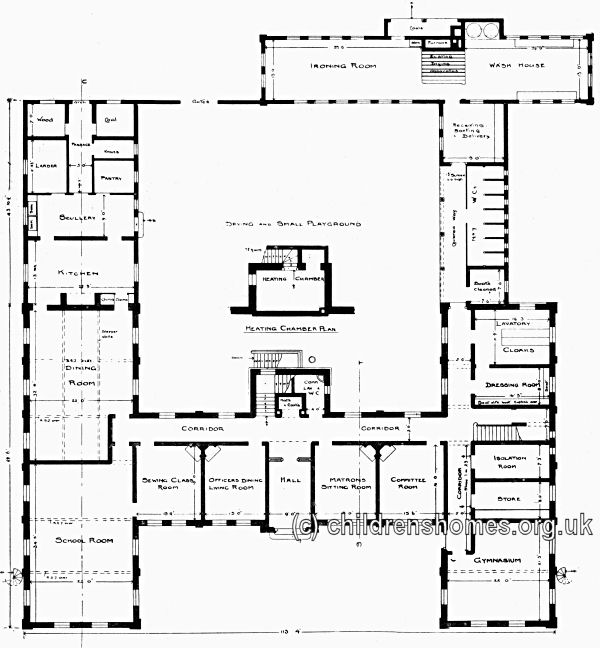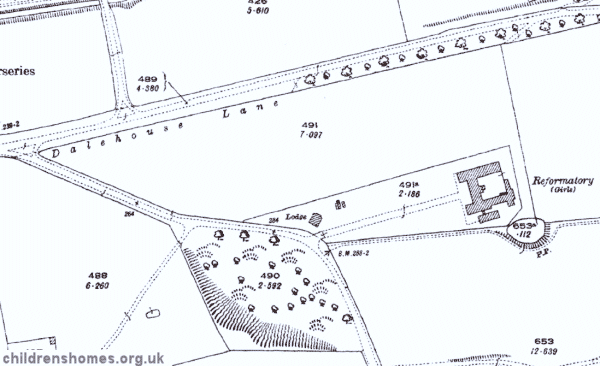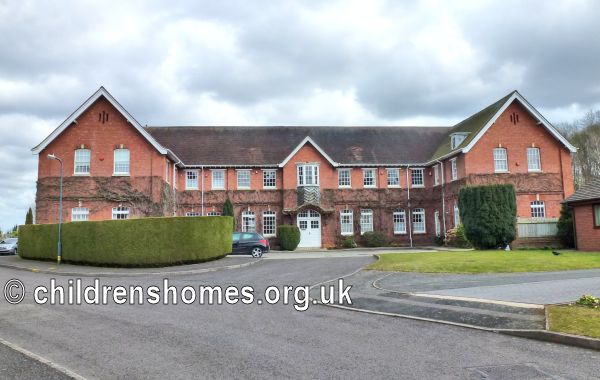Warwickshire Reformatory for Girls, Kenilworth, Warwickshire
In 1907, the Warwickshire Reformatory School for Girls moved from its old site in Coventry to new, purpose-built premises on Dalehouse Lane, Knowle Hill, about two miles from Kenilworth. The building, designed Mr Charles M.C. Armstrong of Warwick, could accommodate 40 girls and a staff of five. It included a large schoolroom, classrooms, committee and officers' rooms, gymnasium, kitchens etc. The large and small dormitories on the first floor were all overlooked by officers' bedrooms. The building work was carried out by Mr Charles Hope of Berkswell, whose accepted estimate was £4,942,

Ground-floor plan of Warwickshire Reformatory for Girls, Kenilworth, 1906. © Peter Higginbotham
The School formally came into operation on March 11th, 1907. Miss A.R. Lockington was appointed as superintendent.
The School site is shown on the 1925 map below.

Warwickshire Reformatory for Girls site, Kenilworth, c.1925.

Warwickshire Reformatory for Girls, Kenilworth, from the west c.1909. © Peter Higginbotham

Former Warwickshire Reformatory for Girls entrance lodge, Kenilworth, 2013. © Peter Higginbotham
Having been closed for several years while the new building was under construction, the School had to build up its numbers from scratch. At the end of 1907, there were only 13 girls in residence. By 1909, however, the School was full and some alterations were made to the buildings to increase its capacity to 50, the new limit coming into effect on December 1st, 1909.

Former Warwickshire Reformatory for Girls main building from the west, Kenilworth, 2013. © Peter Higginbotham

Former Warwickshire Reformatory for Girls main building from the north-west, Kenilworth, 2013. © Peter Higginbotham

Former Warwickshire Reformatory for Girls main building from the east, Kenilworth, 2013. © Peter Higginbotham
Reports on the School were generally good. Classroom work included composition, mental arithmetic, geography, history, recitation and singing. In 1911, it was noted that domestic economy books were read and understood. Laundry work formed a large part of the industrial training, with washing taken in from outside in addition to the School's own requirements. There was also instruction in needlework and dressmaking, and weekly cookery lessons were given. A dentist, Mr G.D. Ross Watt, made regular visits.
In April, 1921, four girls ended up in court after trying to escape from the School. The girls concerned were Saidie Barovitch (16), Faith Whitfield (15), Sarah Briggs (15), and Gladys Hitchin (14). According to the superintendent, Miss Perry, the four had got out of the laundry window and run over some fields. They were brought back, however, by a man and of the other girls, but they proved very refractory. The following morning they had breakfast, but refused to dress, saying they wanted a transfer to another school. The next day, one of the girls found match and lit the fire in the room where they were confined. They were very excited, and Miss Perry had to spend most of the night with them. All the other girls were shouting and practically rioting. One of the girls got nearly as far as Coventry, but she was overtaken by a policeman on a bicycle. Saidie Barovitch claimed she was constantly being taunted about being a Jew.
Another mutiny at the School in May, 1923, was the subject of an internal Home Office report by Dr. A.W. Norris:
OUTBREAK OF INSUBORDINATION at the KENILWORTH TRAINING SCHOOL.
On May 8th I received a telephone message from the new Superintendent of the school, Miss Langley, to the effect that most of the girls were defying the staff, smashing windows and doors, refusing to obey orders and declining to do any work.
One girl, Florence Loch, had threatened to attack the staff with a knife and refused to go to bed at 2 in the morning, and was doing such material damage to the school and inciting the others to riot to an extent which made the Superintendent call in the assistance of the police.
A police inspector and sergeant came out and, in a moment of surprise, this girl of 18 caught the Inspector by the throat, got him on the ground and sat on his head. On the sergeant coming to the rescue she bit him in the arm, the teeth penetrating the flesh to the bone.
I advised Miss Langley to charge the girl under Section II of the Prevention of Crime Act with committing a breach of the rules of the school and with absconding, and this was done the following day. A very foolish magistrate, however, refused to send the girl to Borstal and sent her back to the school. Trouble at once recurred and the Superintendent communicated by telephone to the office in my absence and Miss Wall arranged with Mr. Crapper for the immediate transfer of the girl to Stafford Reformatory where I understand she has settled down.
It was assumed here that things were quiet at Kenilworth and I heard nothing more until the afternoon of the 16th when Mrs. Rotherham, a manager, called here and informed me that the school for some days had been in an almost continuous state of riot. Girls had been out half the night, some of them had even spent the night on motor lorries, two having visited London. The police had attempted to secure the absconders. Windows and doors had been broken; the staff isolated, and all the girls, with the exception of about eight, were disobeying orders.
I went straight down to the school arriving at 9.30 p.m. and although the girls were going to bed there was still a disgraceful noise and I heard a window smash as I entered the school. I stayed till 11 p.m. when matters had quietened down and then left the school after having arranged to be called if there was any trouble. At 7 a.m. I received a telephone message to the effect that there was further trouble and I went straight to the school where I found three girls under 16 had barricaded themselves in one of the dormitories and refused to open the door and were then smashing windows and the panel of the door. They refused to open at first but ultimately did so.
I found one girl of 15 (Dora Help) had been the ringleader for some days amongst the juniors and I advised the Superintendent to inflict corporal punishment which she did forthwith.
After breakfast two of the worst offenders amongst the older girls (Hannah Turner and Violet Bateman) who were then under arrest were brought before the Leamington Petty Session at Milverton, and after much pressure on my part the Magistrate decided to hold a special court and ultimately sent these two girls to Borstal. I regretted to send the younger one aged 16 but it was absolutely essential to make an example to stop the riot.
I then proceeded to the school and addressed all the girls expressing pleasure at the conduct of the eight seniors and informed the others that severe and drastic steps would be taken to establish discipline in the school, that any senior girl continuing any insubordination would be forthwith charged before the Magistrates and sent to Borstal and that any of the younger girls would be corporally punished and I informed them of the extent to which this could be carried out. I further informed them that the amount of money available for the school was limited and that it would be necessary to use the money provided for camp, recreation etc. to repair the damage done by them.
I stayed at the school all night and when I left in the afternoon of the 18th order seemed to be restored I telephoned to the school on Saturday and Sunday and found all going well but visited again on Tuesday morning.
In the meantime, the youngest girl in the school (Ethel Milton), evidently a ringleader amongst the others and who had been absolutely defiant for some days, had behaved very badly, had refused to work and had used very foul language to the staff. The Superintendent there had given her severe corporal punishment — perhaps rather too severe though justified under the special circumstances.
Before leaving the school on the 22nd I had a conference with some of the Managers and saw the girls at work and am of the opinion that the trouble has practically ceased. The Managers throughout had been helpful and grateful for my assistance and I think on the whole the Superintendent has acted sensibly and has been supported by her staff. I believe that the whole trouble was a conspiracy on the part of the girls to get rid of the new Superintendent, having realised that the absolute want of discipline and lazy habits allowed by the late Superintendent were about to end. I have discussed the matter fully with Miss Wall who will keep an eye on the school.
In 1933, the establishment became an Approved School, one of the new institutions introduced by the 1932 Children and Young Persons Act to replace the existing system of Reformatories and Industrial Schools. Knowle Hill School, as it was now known, accommodated up to 40 Senior Girls aged between their 15th and 17th birthdays at their time of admission. The School was officially described as 'a country school giving domestic training'. Facilities for the treatment of venereal disease were provided at the School.
In 1973, the school became a Community Home with Education (CHE) under the control of Warwickshire County Council. The Home closed in 1985 and the site sold. The proceeds from the sale went to create the Knowle Hill School Fund to support students from Warwickshire needing financial support in their postgraduate education.
The former School premises, now known as the Old School House, have been converted to residential use.
Records
Note: many repositories impose a closure period of up to 100 years for records identifying individuals. Before travelling a long distance, always check that the records you want to consult will be available.
- The National Archives, Kew, Richmond, Surrey, TW9 4DU. Has a number of reports including:
File: HO 45/14545 — Knowle Hill Training School for Girls: model rules and corporal punishment (1917-1932).
File: MH 102/10 — Knowle Hill School, Kenilworth: report on the outbreak of venereal disease at the school by the Chief Inspector (1930)
File: MH 102/428 — Knowle Hill School for Girls, Kenilworth: riot and disorders at the school, report by local police inspector (1945) [Closed until 2020]
Bibliography
- Carpenter, Mary Reformatory Schools, for the Children of the Perishing and Dangerous Classes, and for Juvenile Offenders (1851, General Books; various reprints available)
- Carlebach, Julius Caring for Children in Trouble (1970, Routledge & Kegan Paul)
- Higginbotham, Peter Children's Homes: A History of Institutional Care for Britain's Young (2017, Pen & Sword)
- Abel Smith, Doroth Crouchfield: A History of the Herts Training School 1857-1982 (2008, Able Publishing)
- Garnett, Emmeline Juvenile offenders in Victorian Lancashire: W J Garnnett and the Bleasdale Reformatory (2008, Regional Heritage Centre, Lancaster University)
- Hicks, J.D. The Yorkshire Catholic Reformatory, Market Weighton (1996, East Yorkshire Local History Society)
- Slocombe, Ivor Wiltshire Reformatory for Boys, Warminster, 1856-1924 (2005, Hobnob Press)
- Duckworth, J.S. The Hardwicke Reformatory School, Gloucestershire (in Transactions of the Bristol and Gloucestershire Archaeological Society, 1995, Vol. 113, 151-165)
- Higginbotham, Peter Children's Homes: A History of Institutional Care for Britain's Young (2017, Pen & Sword)
- Hyland,Jim Yesterday's Answers: Yesterday's Answers: Development and Decline of Schools for Young Offenders (1993, Whiting and Birch)
- Millham, S, Bullock, R, and Cherrett, P After Grace — Teeth: a comparative study of the residential experience of boys in Approved Schools (1975, Chaucer Publishing)
Links
- Red Lodge Museum, Bristol — a former girls' reformatory.
Except where indicated, this page () © Peter Higginbotham. Contents may not be reproduced without permission.


